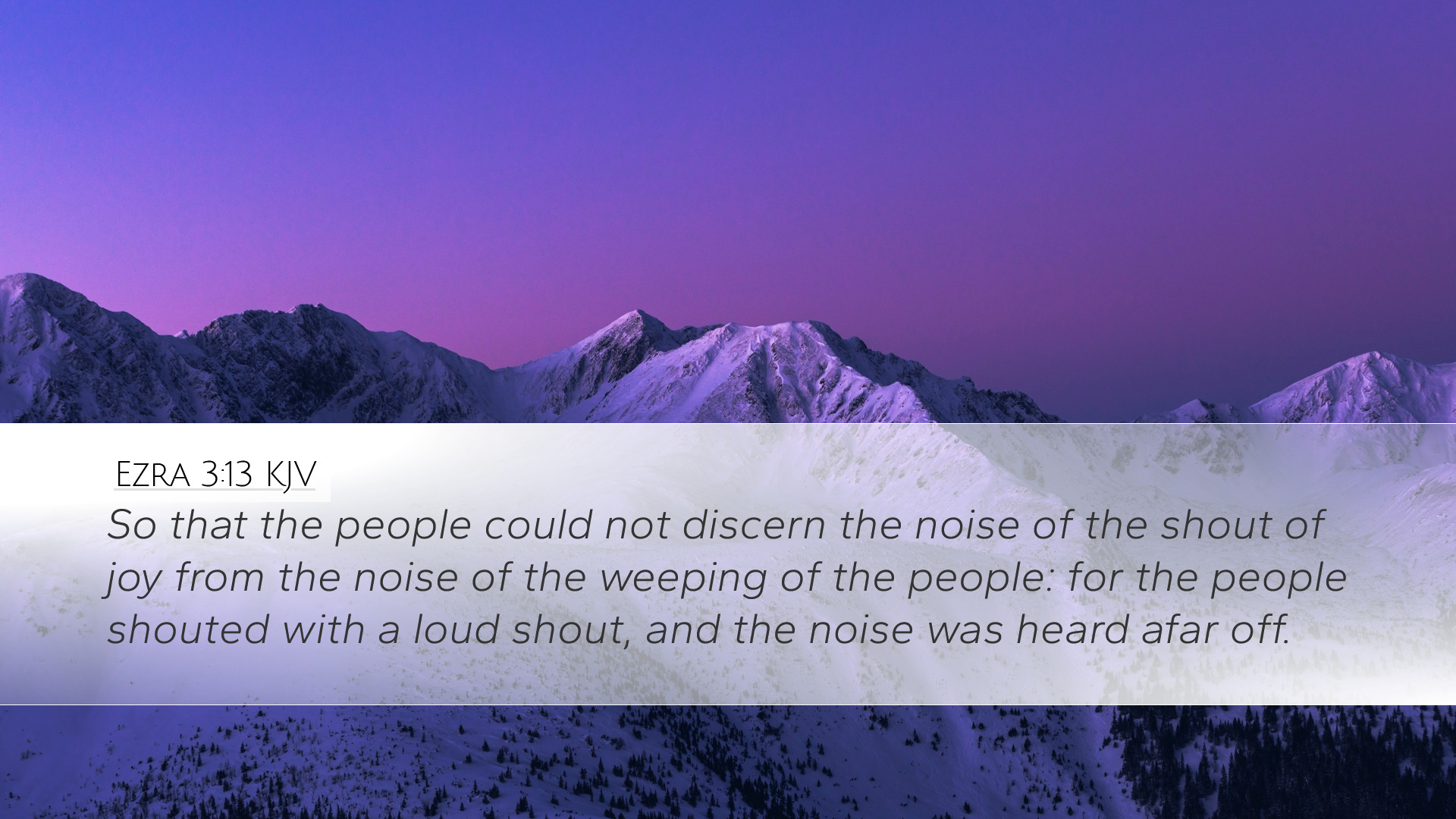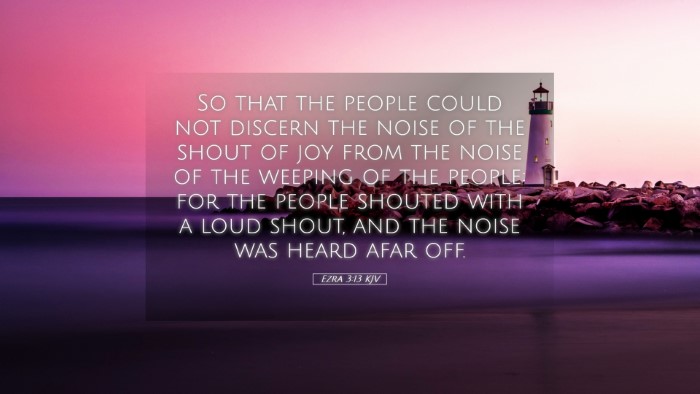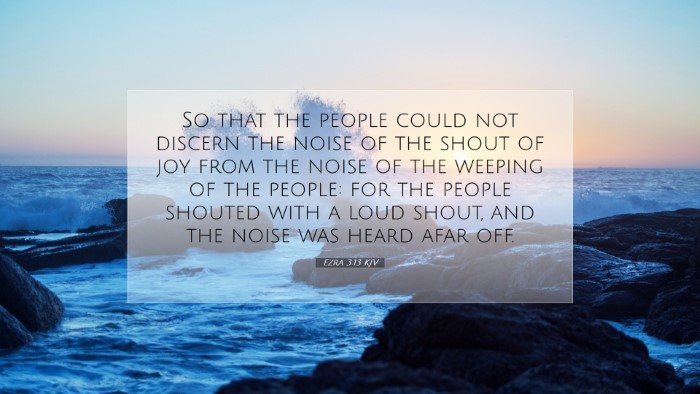Old Testament
Genesis Exodus Leviticus Numbers Deuteronomy Joshua Judges Ruth 1 Samuel 2 Samuel 1 Kings 2 Kings 1 Chronicles 2 Chronicles Ezra Nehemiah Esther Job Psalms Proverbs Ecclesiastes Song of Solomon Isaiah Jeremiah Lamentations Ezekiel Daniel Hosea Joel Amos Obadiah Jonah Micah Nahum Habakkuk Zephaniah Haggai Zechariah MalachiEzra 3:13
Ezra 3:13 KJV
So that the people could not discern the noise of the shout of joy from the noise of the weeping of the people: for the people shouted with a loud shout, and the noise was heard afar off.
Ezra 3:13 Bible Commentary
Commentary on Ezra 3:13
Ezra 3:13 states: "So that the people could not discern the noise of the shout of joy from the noise of the weeping of the people: for the people shouted with a loud shout, and the noise was heard afar off." This verse captures a significant moment in the re-establishment of worship in Jerusalem after the return from Babylonian exile. It reflects deep emotions, a mixture of joy and sorrow among the returned exiles as they initiate the rebuilding of the temple.
Historical Context
The return of the exiles, as narrated in the book of Ezra, was a pivotal moment in Jewish history. After decades of captivity, the Jewish people, led by Zerubbabel, began to restore their identity and worship practices. Ezra's account emphasizes both the communal effort and the emotional weight of restoring the temple.
Insights from Matthew Henry
Matthew Henry provides rich insights into this passage. He highlights that the mixed responses of joy and weeping signify two groups among the returned exiles: those who remembered the former glory of the first temple and those who rejoiced at the prospect of worship being restored. He notes that the old men who had seen Solomon’s temple wept, seeing the new structure as lacking in comparison.
- Emotional Contrast: The emotional contrasts are significant in understanding the complexities of returning to one's homeland after a long absence.
- Recognition of God's Faithfulness: Henry stresses that amidst sorrow, there was profound joy—God’s promise of restoration was being fulfilled, leading them to renew their worship.
- Communal Experience: This event was not only a personal experience but a communal one, demonstrating the unity of God's people even in diversity of feelings.
Reflections from Albert Barnes
Albert Barnes offers a theological reflection on this passage, underscoring the significance of worship and the community’s response to God's acts. He notes that the mixed sounds of joy and weeping indicate that the memories of past glories can overshadow present realities.
- Worship’s Dual Nature: Barnes points out that worship has a dual nature—while it elicits praise and joy, it also confronts the reality of loss and longing for what once was.
- God’s Presence Amidst Diversity: He argues that God’s presence can be felt even in the midst of sorrow. The distinction between joyful shouts and weeping shows that worship encompasses the full range of human experiences.
- Proclamation of Praise: This generates an atmosphere of worship where the sounds of praises become evident and resonate with the community.
Adam Clarke's Exegesis
Adam Clarke provides a detailed exegesis of the verse, exploring the implications of the scene depicted. He notes the structure of the temple being rebuilt was inferior to Solomon’s, which likely caused grief among the elders.
- Cultural Reflection: Clarke draws attention to the cultural significance of the temple. For the Jews, it represented a tangible connection to God that they longed to reclaim.
- Sound and Silence: The inability of the crowd to discern between joy and weeping highlights the intensity of emotions. Clarke emphasizes the importance of recognizing that expressions of emotion are a natural part of worship.
- Wider Implications: Clarke contemplates the broader implications of this event, noting that the people were united in their endeavors to rebuild their identity and spiritual home.
Theological Implications
In a broader theological context, the scene described in Ezra 3:13 serves as a powerful reminder of the complexities of communal worship. Pastors and theologians may draw several critical lessons from this event:
- The Nature of Memory: The narratives of communities often blend joy and sorrow, reflecting the reality that faith development often involves processing past experiences even as one seeks to move forward.
- Community Dynamics: The dynamics within worshipping communities can involve diverse experiences—acknowledging this can foster space for healing and authentic expression of faith.
- Hope Amidst Pain: This passage captures the essence of hope in despair, showing that restoration does not erase past pain but creates new opportunities for communal identity and faith.
Practical Applications for Worship
Given the emotional landscape reflected in Ezra 3:13, there are valuable applications for today’s worship practices:
- Inclusivity in Worship: Encouraging authentic expressions of grief and joy can cultivate a welcoming atmosphere in church services where individuals feel free to express their experiences.
- Recognition of Journey: Acknowledging the journey of congregants can be a powerful aspect of ministry, allowing space for varying degrees of emotional responses during worship.
- Teaching Biblical History: Using historical narratives like this can enhance Bible teaching, offering lessons on the importance of community in faith practices.
Conclusion
Ezra 3:13 stands as a poignant reminder of the complexities of worship, particularly the interplay between joy and sorrow in the life of a faith community. As we reflect on this passage, we are encouraged to embrace the full spectrum of human emotion in our walk with God and to affirm that both weeping and shouting can coexist in sacred spaces, enriching our worship experience.


